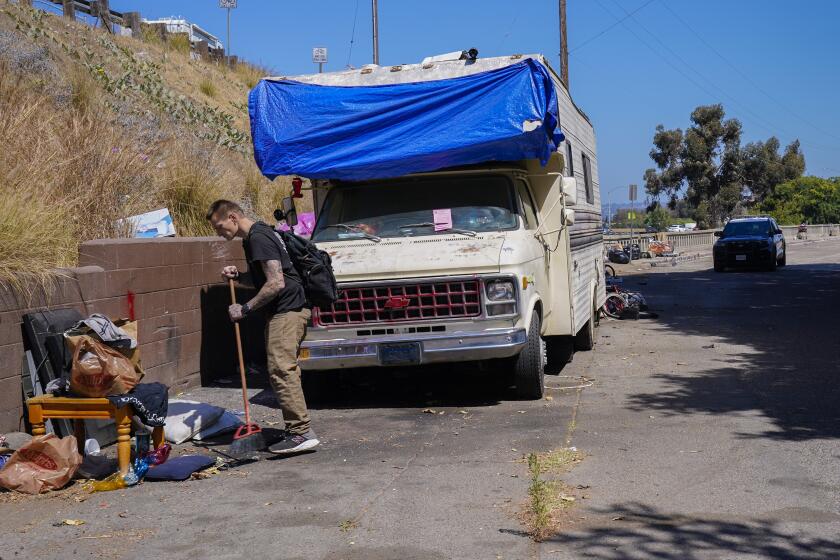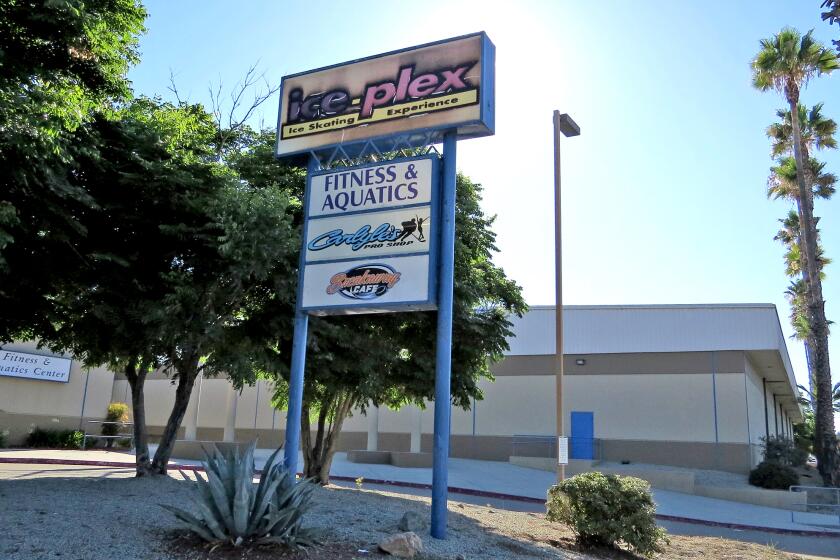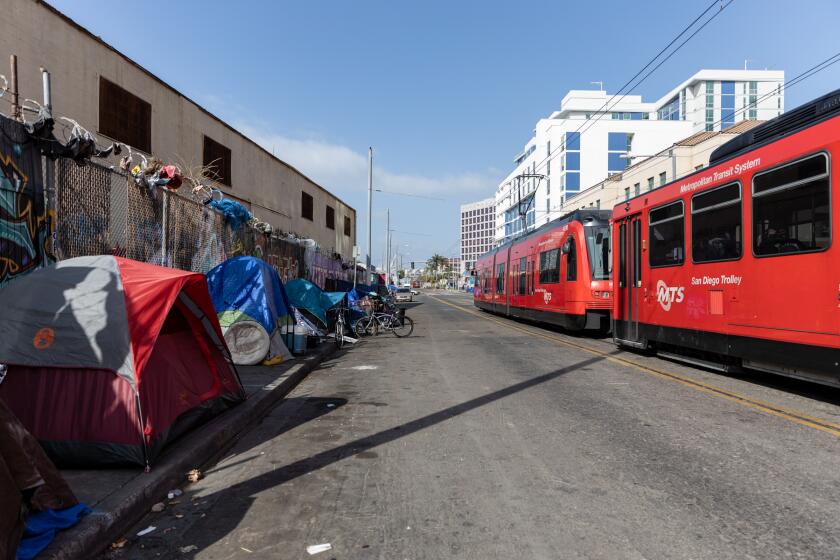Power-washing is a dirty job, but could help contain hepatitis A outbreak

The hepatitis A virus is spread through fecal matter, and the homeless population is particularly vulnerable because they have limited access to toilets and places to wash their hands.
More than a few people took a second look at the trucks with flashing lights and men in hazmat suits spraying chemicals on sidewalks in several San Diego neighborhoods Friday.
“Is it ok if I go through?” one man asked as he stopped before stepping on the wet sidewalk in the Midway area.
He was told it was fine, despite the slight chemical smell of bleach e that arose as the wet sidewalk heated up around 8 a.m. on Rosecrans Street.
It was unclear whether he knew the crew he passed was spraying sidewalks because they might have, among other things, traces of human feces that could contain a deadly virus.
“That’s urine,” one of the crew members said just after the pedestrian passed, pointing out a tale-tell white foam that emerges as the chemicals lingered on a sidewalk in front of a bus stop.
Needless to say, it’s not the most glamorous job. But it is a job that has brought the new national attention to the effort to help contain a hepatitis A outbreak that has left 17 dead and hundreds hospitalized over the months of the outbreak.
ABC News, CNN, Newsweek and the Washington Post have reported on the effort to stop the deadly outbreak, and a team from the HBO newsmagazine “Vice” followed the crew as they walked down Rosecrans Street on Friday.
The hepatitis A virus is spread through fecal matter, and the homeless population is particularly vulnerable because they have limited access to toilets and places to wash their hands.
To fight the spread, the city has set up public toilets and hand-washing stations downtown and has evicted people from large sidewalk campsites. On Friday, city crews also moved homeless people out of campsites along the San Diego River.
Clearing away unsanitary tents was one step in stopping the spread of the disease, but the virus still may be on sidewalks, embedded, unseen and dangerous if picked up on a shoe that’s later touched.
On Sept. 11, Clean Harbors Environmental Services began cleaning sidewalks with chemicals downtown, and this week they expanded to Ocean Beach, Pacific Beach and the Midway area. On Friday, they finished in Midway and moved on to North Park, Park Boulevard and Colina Park.
“Although the city has had limited sanitizing efforts in the past, the current sidewalk sanitizing work is the largest scale, widespread project of its kind for us,” said Mario Sierra, director of the city’s Environmental Services Department. “Public safety and public health must be prioritized, and I’m confident that sanitizing work is making a difference.”
The washing is done in two phases. First, a team of two sprays diluted sodium hypochlorite (bleach) on sidewalks from small containers that are pressurized by hand.
That solution is diluted at a ratio of one gallon of hypochlorite to nine gallons of water. It sits on the sidewalk for 10 minutes before a third crew member arrives spraying another solution created by further diluting the first solution with water in a one-to-nine ratio.
Much more of the second solution is sprayed than the first, and it’s shot with a gas-powered pump from a 275-gallon plastic tank hauled on a short trailer behind a Clean Harbors pickup truck.
So much is sprayed, the team has to periodically stop at fire hydrants to refill the tank. There is, however, no runoff, as the spray was more like a mist that occasionally made a rainbow and left sidewalks wet, but not puddled.
One of the crew members said they have absorbent socks to place over storm drains if necessary to catch any runoff, but they have not had to use them. While high-pressure pumps can be strong enough to blast gum off sidewalks, these are turned down to a soft spray because that’s all that’s needed for this job, a crew member said.
While Clean Harbors employees said they are not allowed be quoted as spokespeople for their company, they were happy to answer questions. The diluted solution is harmless on the sidewalk, one explained, and the hazmat suits are necessary because the spray would stain the crew member’s clothes.
The men walked down Rosecrans from Kurtz Street to Pacific Highway, where homeless people often set up tents. Not today, however. Bright pink notices were posted in advance to alert people the crew was headed their way. If they did come upon a tent, city communications director Katie Keach said the crew would just spray around them because they don’t have authority to make them move.
At the next stop at North Park Community Park, Curtis Jimison noticed the crew as he pushed a shopping cart full of bottles and cans he plans to recycle. He’s been “kind of” homeless for two years, he said.
“I’m concerned for a lot of the people, but I try to keep myself really clean,” he said about the hepatitis A outbreak.
As he spoke, Jimison washed his hands with a bottle of water and hand soap he keeps in his cart, a routine he does about every 15 minutes when collecting recyclables.
He has kept up on the news about the outbreak and said he has noticed the city has finally begun refilling the soap dispenser in the park’s restroom, although the sink had no water.
The crew next made their way down University Avenue in North Park, walking from 32nd to Texas Street.
Many people didn’t take notice of the crew, which bypassed stretches that had people sitting in outdoor dining areas.
Others were happy to see them, with some waving and thanking them.
Clee Gonzales, a manager at North Park Flooring, was especially appreciative but wished they would have also cleaned the alley behind his shop.
“We’re very relieved to see they’re actually doing something,” he said. “They’ve been talking about it for months, but we hadn’t seen any actions taken.”
Gonzales said homeless people defecate behind the shop, and since hearing about the hepatitis A outbreak everybody at work has worn gloves when in the back and disinfected their shoes afterward.
“I just know it’s out there. and it makes me nervous,” he said about the disease.
The city is asking the public to report other areas that should be washed by calling (619) 527-7500 or by making an online request at sandiego.gov.
Homeless Playlist

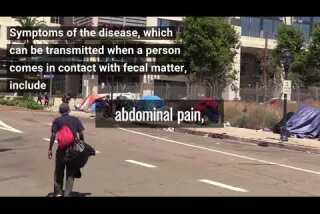
San Diego hepatitis outbreak continues to grow: 481 cases
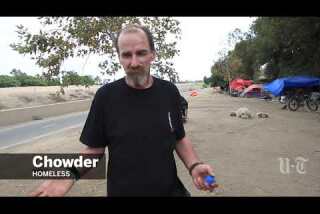
Homeless entrenched in booming tent city along Santa Ana River
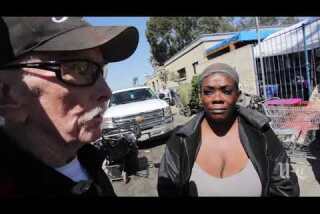
San Diego mayor agreed to homeless hub, then delayed, advocates say
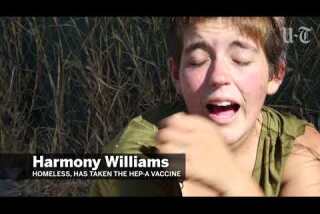
Homeless outreach in San Diego
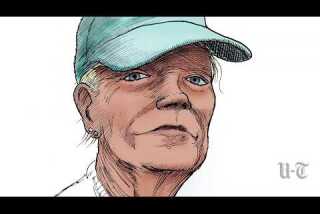
Video: Street Art: Portraits of San Diego's Homeless #8

Street Art: Portraits of San Diego's Homeless #7

Pitching a tent plan for San Diego's homeless

Homeless efforts get $80M boost for various services
760-529-4939

